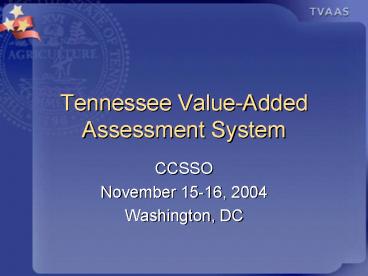Tennessee ValueAdded Assessment System - PowerPoint PPT Presentation
1 / 29
Title:
Tennessee ValueAdded Assessment System
Description:
Required by state statute in 1992. Used statistical methodology developed in the '50's but the first time it was ... Dr. William L. Sanders and his colleagues ... – PowerPoint PPT presentation
Number of Views:51
Avg rating:3.0/5.0
Title: Tennessee ValueAdded Assessment System
1
Tennessee Value-Added Assessment System
- CCSSO
- November 15-16, 2004
- Washington, DC
2
History
- Required by state statute in 1992
- Used statistical methodology developed in the
50s but the first time it was applied to an
educational problem - Dr. William L. Sanders and his colleagues at the
University of Tennessee - First study, Knox County, early 80s
- Published in open literature--
3
Conceptual Understanding
- Follow the progress of an individual child over
time - Aggregate the progress for a population of
students - All students count
4
Value-Added for Accountability
- Value-added measures the influence of schooling
on student progress - District
- School
- Teacher
5
The TVAAS Model
- Real world data
- Some students have missing scores
- Some tests are not reported on the same scale
- Most precise, reliable estimates
- Include all students, even those with missing
scores - Scores for up to five years on the same student
- Analyzes all subjects simultaneously
- Accommodates test results reported on different
scales
6
Value-Added Tells You
- Does your curriculum fit your students?
- Do your instructional strategies work?
- Do all students have an opportunity for growth?
7
Value-Added for Diagnostic Use
- Do your students at all achievement levels make
progress?
8
Does growth in a single year really matter?
9
Narrow curricular focus can cause a pattern like
this.
?
10
Student Strategies
- Identify at-risk students
- Identify students who should excel...maybe even
beyond their assigned grade - Apply resources based on student need
- Be gender, color, and economic blind while you
focus on individual students and what they need
academically
11
Step by Step
- Select Custom Student Report
12
Custom Student Report
- Administrative reporting function that allows
the user to - Access students demographics
- Access students probabilities for success in
future years - Link to the historical data for each student
identified in your search
13
Student Prediction
- Answers the questionhow will a student perform
on a subsequent test if he or she has an average
Tennessee schooling experience? - The prediction takes into account all of the
previous testing history of the student in all
subjects, minimizing the error in a single score.
14
(No Transcript)
15
Custom Student Report
16
Custom Student Report
17
Custom Student Report
18
Custom Student Report, Performance Level
- Select Grade/Subject/Performance Level according
to your interest
19
Select Probability Range to Answer Your Question
- Select higher ranges to identify students with a
good probability of passing. - Note if a student has a high probability for
passing a test, the student may be at-risk if the
school fails to recognize his or previous
achievement.
20
Example of Higher Ranges
21
Hispanic Students with High Gateway Algebra
Probabilities
22
Example of Lower Ranges
- If a student has a low probability for passing a
test, the student is at-risk for failing. - Note something below 50 for the upper limit
would be acceptable for identifying students with
lower ranges
23
Lower Range Probabilities
24
Hispanic Students with Low Probabilities for
Success on Gateway Algebra
25
Assign Students to Teachers
26
With the Custom Student Report, Principals may
- Assign students to teachers
- Determine students who need special tutoring
- Determine AYP subgroup students who will suffer
if held back at a slower pace - Select students for Algebra I versus Math
Foundations
27
For Guidance Counselors
- Its never too early to plan for the future
- Whether students immediate goal is passing CRTs
or not - Look beyond the current year to graduation and
college
28
Teachers
- See their students historical testing
information - See their students predictions to subsequent
proficiency levels
29
High
H H
L H
A C H I E V EM EN T
L L
H L
High
Low
P R O G R E S S































